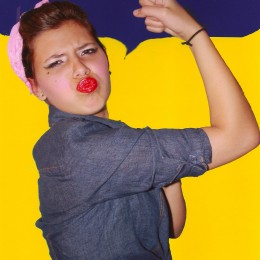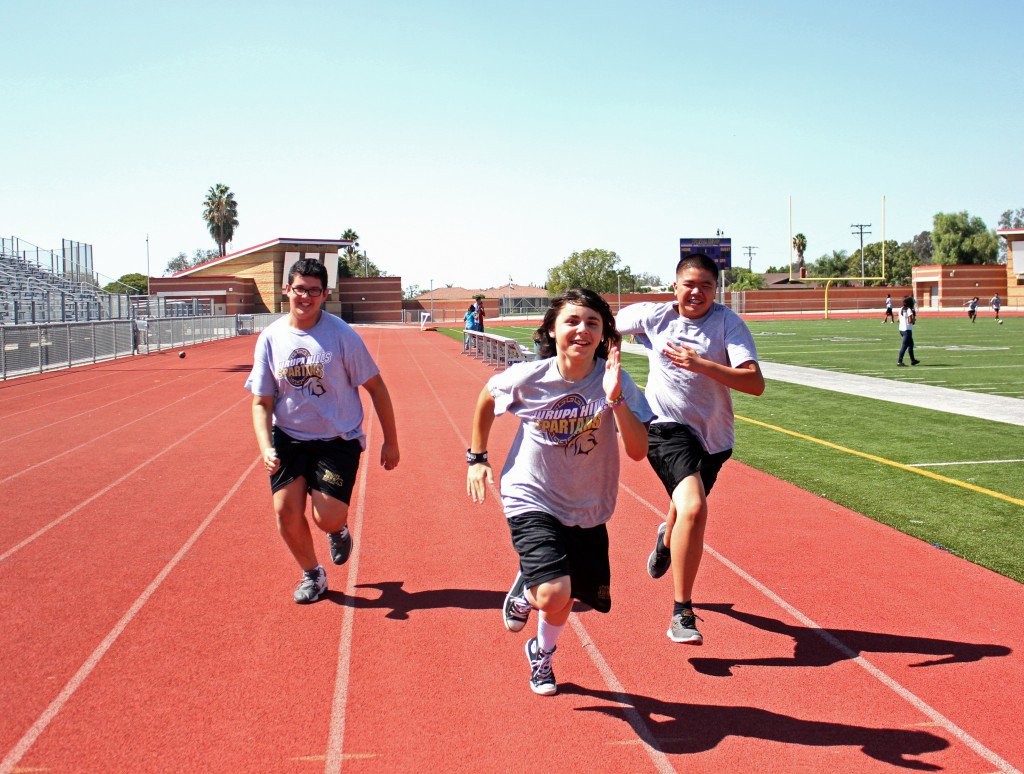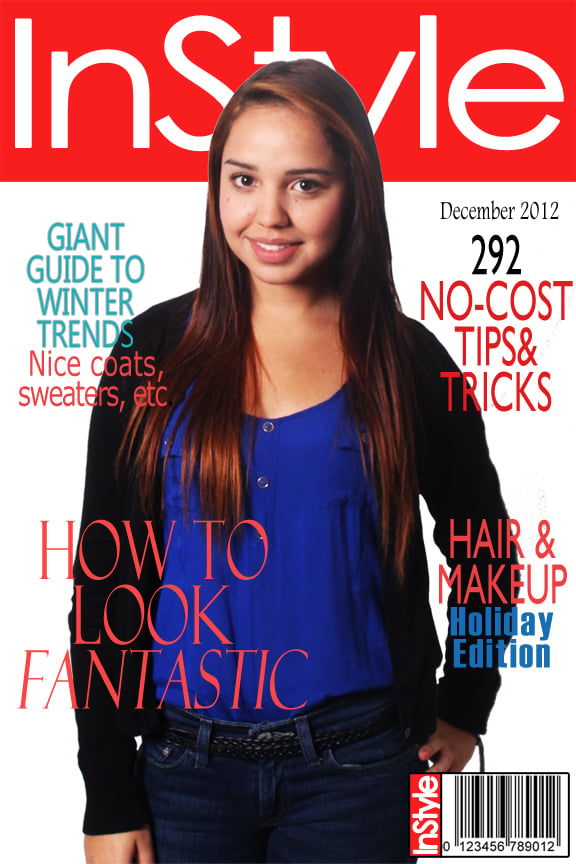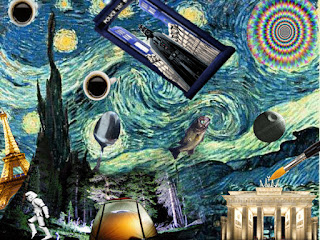What were three things you enjoyed learning so far in Digital Photo II?
1.
2.
3.
What has been your favorite project so far?
What was your least favorite project so far?
Do you feel your skills in photography have improved during the semester?
If you could re-do one project, which one would it be and why?
Was Ms. Baron a professional, helpful, and knowledgeable teacher?
Is there a project/skill you would like to learn next semester?
COMMENTS or COMPLAINTS?:
Tuesday, December 8, 2015
Monday, December 7, 2015
Digital Photo I Survey
Why did you take Digital Photo I?
What were three things you enjoyed learning so far in Digital Photo I?
1.
2.
3.
What has been your favorite project so far?
What was your least favorite project so far?
1.
2.
3.
What has been your favorite project so far?
What was your least favorite project so far?
Are you interested in taking Digital Photo II?
Do you feel your skills in photography have improved during the semester?
If you could re-do one project, which one would it be and why?
Was Ms. Baron a professional, helpful, and knowledgeable teacher?
Is there a project/skill you would like to learn next semester?
COMMENTS or COMPLAINTS?:
Tuesday, December 1, 2015
Digital Photo I & II: Design a Holiday Card
Winter break is just around the corner! This is the last project we will do before finals prep.


Take photographs of your family, friends, or pet and create a Holiday card design in Photoshop. There should be a good balance of photo editing, layout design, color scheme, and use of text. Include at least two photos in your design.
Requirements:


Take photographs of your family, friends, or pet and create a Holiday card design in Photoshop. There should be a good balance of photo editing, layout design, color scheme, and use of text. Include at least two photos in your design.
Requirements:
- Two or more photos taken by you to incorporate in your card design. (i.e.: family, friends, pets, a winter landscape, etc.)
- Edit photos contrast, brightness, color saturation, levels, etc.
- Card front should be 4 inches by 5 inches.
- Choose a color scheme for the shapes and graphics that you wish to include.
- Use guides and shape tools in Photoshop to create the card layout.
- Pick a decorative font that fits your design. Include some text.
- Save design and post to blog no later than December 11th at the beginning of class.
Get creative and create a humorous or witty scene to photograph for your Holiday card. Check these out:
Digital Photo I & II: Taking Better Architecture Photos

Read this article about improving your architecture photography. Answer the following questions on your blog:
- How can you adjust lines in your photography?
- How does organizing your capture help the final photo?
- Explain three more tips that you learned from this article that you find helpful.
Once you have completed yesterdays and today's blog assignments, think about locations accessible to you that you can capture architecture photography. Remember interior and exterior architecture are allowed in your photographs.
Post 4 of your best photos by Wednesday, 12/2, at the end of class.
Monday, November 30, 2015
Digital Photo I & II: Architecture Photography

Much as building designs changed and broke with traditional forms, architectural photography also evolved. During the early-to-mid-20th century, architectural photography became more creative as photographers used diagonal lines and bold shadows in their compositions, and experimented with other techniques.
- Take a look at these architecture photographers.
- Choose 3 photos from the article above and share them on your blog along with the photographer's name.
- Explain WHY you choose each photo. Describe the strengths or successes of each photo.
Tuesday, November 17, 2015
Digital Photo II: Re-Create a Work of Art
Look at famous and original works of art online. (Dali, O’keefe, Kandinsky, Picasso, Van Gogh, Warhol, etc.) Take a look here if you are stumped. Select a famous work of art to recreate with photography and Photoshop techniques. Using Photoshop tools, try to make your replica as close to the original as possible. Explore brushes and colors. Your final image should be heavily edited.
Post your final reproduction to your blog with the name of the artist and the title of the artwork you based your photo off of.
Post your final reproduction to your blog with the name of the artist and the title of the artwork you based your photo off of.
This project is due November 24th at the end of class.
Look at samples below:




Monday, November 16, 2015
Digital Photo I: Photographer Presentation
Photographer Presentation

You will produce and present a PowerPoint presentation about a professional photographer of your choice. Now is your chance to research and share what you learn with other photography students in this class. The requirements for this presentation are a minimum of 15 slides and must include the information below. If you have trouble finding a photographer, you may choose from one of the lists below or from a Capture episode we watched in class. It is often best to answer each number question on one slide each. Email your presentation to jbaron@psd202.org, save on the shared drive, or bring in on a flashdrive by the beginning of class on Monday, November 23rd.
This project is worth a total of 50 assessment points, and will dramatically affect your grade if turned in late or incomplete. All students are expected to present their slides in front of the class on November 23rd or 24th.
Presentation Criteria
- What is the photographer’s real name and year he or she was born and where? Is he/she still alive?
- What is their style of photography (ex: photojournalism, editorial, documentary, advertising, portraits, magazine, sports, war, etc.)?
- Are there any special photography techniques this photographer uses in his/her work? (Think about composition, depth of field, editing, etc.)
- Who does the photographer work for?
- What type of cameras and lens does this photographer work with, and why?
- What type of lighting does this photographer primarily use and why?
- Who are some of the photographer’s early influences?
- Are there any interesting stories about this photographer or his/her work?
- What do you like (or not like) about their work, and why did you select this photographer?
- What is their most well know/famous photo? Why is it so popular?
- Include photos of the photographer and their work throughout your presentation. EVERY slide should have at least one photo! A total of 15 slides are required.
- You may include a short video clip in your presentation if you desire. (not required)
Thursday, November 12, 2015
Capture Episode #1 Questions
Capture Episode #1
Which photographer's work do you personally prefer? Platon or Dylan McDermott?
Where does Dylan McDermott go to take the best photos and why is it so fantastic to photograph?
Platon says he does not think of himself as a photographer anymore. What does he say he is?
Both Platon and Dylan McDermott talk about today's society and how it have been "robbed" by technology. What has technology taken from us according to Platon? Do you agree with the statements they make about communication today? Why or why not?
Describe a photo you saw in the episode that you felt was an exceptional photo.
Capture Episode Playlist
Which photographer's work do you personally prefer? Platon or Dylan McDermott?
Where does Dylan McDermott go to take the best photos and why is it so fantastic to photograph?
Platon says he does not think of himself as a photographer anymore. What does he say he is?
Both Platon and Dylan McDermott talk about today's society and how it have been "robbed" by technology. What has technology taken from us according to Platon? Do you agree with the statements they make about communication today? Why or why not?
Describe a photo you saw in the episode that you felt was an exceptional photo.
Capture Episode Playlist
Tuesday, November 10, 2015
Digital Photo I & II: Capturing Movement
Photographs, by definition, capture and immortalize a small slice of life. There is little for the viewer to infer what happens before or after that moment. However, there are images that need to communicate movement. For example, you may want to capture a dog running, a train barreling down the tracks, or trees that are blowing in the wind. Each of these scenes can come alive within your photographs if you learn how to convey motion properly.
Complete the work below and post to your blog by the end of class on Monday, November 16th. You may include all parts of this assignment in one blog post or several.
- Take a look at this article about capturing action/motion photography and write a four sentence reflection about what you learned about motion photography techniques.
- Find 2 photos online, one showing action sharp and another showing motion blur. Post both images to your blog.
- Take photos outside that capture ACTION SHARP. Try to “capture the moment”. Take several photos, edit and post your favorite 2 shots.
- Take action photos inside trying to capture MOTION BLUR. Let blur create movement in your photos. Take several photos, edit and post your favorite 2 shots.
Examples:
 |
| Action Sharp |
 |
| Motion Blur |
Monday, November 9, 2015
Digital Photo I: Mirror Image
Find a interesting photo with lots of lines, forms, or shapes. Edit the photo to intensify the color or contrast. Put the edited photo in a new document and make a copy of the image to flip to make mirror imagery using the transform tools. Create a mirror image from online and a mirror image of one of your own photos. Post to blog.
YOUR WORK:
 |
| Colin |
 |
| Skye |
 |
| Connie |
 |
| Ivan |
 |
| Addy |
 |
| Alegna |
 |
| Tim |
 |
| Niki |
Friday, November 6, 2015
Capture Episode #6
Which photographer's work do you personally prefer? Mikhail "Misha" Baryshnikov or Ben Lowy?
What photo is Ben Lowy's tattoo based off of? Explain.
What photo is Ben Lowy's tattoo based off of? Explain.
How does Ben Lowy take his photos during the Iraq War to show the soldier's perspective?
Where does Baryshnikov go to photograph his work? What theme runs through his work?
Describe a photo you saw in the episode that you felt was an exceptional photo.
Where does Baryshnikov go to photograph his work? What theme runs through his work?
Describe a photo you saw in the episode that you felt was an exceptional photo.
Monday, November 2, 2015
Digital Photo I: Animal Morph
Morph together two different animals to create a new species. Blend the images together seamlessly to look as if they are one animal. Think about merging textures/patterns that the animals may have. The clone stamp tool, color balance, transform, erase, and selection tools will assist you in creating a successful morph. Name your new animal species and post it to your blog when you are finished.
One of the most important things you can do is to make sure you find images that can be easily combined. This means searching out photos where the subjects are positioned in similar environments and perspective. Once you do that, it will make erasing the away the parts you don't need and incorporating the various elements that much easier.
One of the most important things you can do is to make sure you find images that can be easily combined. This means searching out photos where the subjects are positioned in similar environments and perspective. Once you do that, it will make erasing the away the parts you don't need and incorporating the various elements that much easier.
- Search online for two different animal images that will work together to morph.
- Open both files in PS.
- Choose one photo to be the "foundation" photo.
- Drag the second photo into your foundation photo.
- Erase what you DON'T need from the second photo layer.
- Remember to try using different opacity percentages to get a blended transition between photos! The morph should look convincing!
- Fine tune by editing the saturation, contrast, levels, and tone of the photos. You will need to alter the color balance/levels of the second image to coordinate with the foundation image.
- Save finished image as a .JPG and post to your blog with the name of your new species!
Examples:





YOUR WORK:





YOUR WORK:
 |
| Alegna |
 |
| Niki |
 |
| Addy |
 |
| Colin |
 |
| Connie |
 |
| Enrico |
 |
| Ivan |
 |
| Jade |
 |
| Tim |
 |
| Skye |
Friday, October 30, 2015
Capture Episode #7 Questions
Which photographer's work do you personally prefer? Helena Christensen or Mary Ellen Mark?
Do you think Helena Christensen's experience as a model in front of the camera had something to do with her success behind the camera? Explain.
What did Mary Ellen Mark mean when she said, "camera companies don't want to know you anymore."
Describe a photo you saw in the episode that you felt was an exceptional photo.
Capture Episode #7
Do you think Helena Christensen's experience as a model in front of the camera had something to do with her success behind the camera? Explain.
What did Mary Ellen Mark mean when she said, "camera companies don't want to know you anymore."
Describe a photo you saw in the episode that you felt was an exceptional photo.
Capture Episode #7
Tuesday, October 27, 2015
D.P. I: Magazine Cover
Create a magazine cover using your own photographic image. Include a cover title and a list of articles, which would be within the magazine.
Think about the type of photography you see on a magazine cover and what it promotes. Search and share 5 magazine covers you will draw inspiration from and post them to your blog today. Think about:
- What type of magazine cover will you design?
- What photo subject will be on the cover?
- Font and typography? Color palette?
This project is due Friday, 10/30, and should be posted to your blog!
Examples:

Monday, October 26, 2015
Digital Photo I: Texture Comments
Choose 3 fellow students to comment on there texture photos. Include WHY you like their photos or what could be an improvement.
Don't forget, your texture photos are due today!
Don't forget, your texture photos are due today!
 |
Friday, October 23, 2015
Capture Episode #4 Questions
Answer these questions on your blog:
Do you agree with Kevin Bacon’s statement about how musicians
are better photography subjects than actors?
Why?
Which photographer’s work did you enjoy more? Bob Gruen or Kevin Bacon? Why?
What stands out to you?
Describe a photo you saw in the episode that you felt was an
exceptional photo.
Why do you think Bob Gruen photographed the Clash and Green Day in the
same location?
Did you enjoy the episode? Would you be interested in watching another episode in class?
Capture Episode #4
Did you enjoy the episode? Would you be interested in watching another episode in class?
Capture Episode #4
Wednesday, October 21, 2015
Digital Photo I: Texture Study

Read this article and answer the following questions in a blog post:
1.) What are the 3 types of texture photography?
2.) What two forms of contrast does texture take?
3.) What two categories do texture curves fall into?
4.) How can texture create mood? What emotions do certain lines convey?
5.) How can you break a pattern in your photographs?
NEXT:
- Find one photo online that shows amazing texture and include it with your answers to your questions above.
- Take 3 photos of different textures. Bring them to class tomorrow for subtle retouching and to post on your blog.
Monday, October 19, 2015
Digital Photo II: On Location Senior Portraits
On Location Senior Portrait Session Project
Photograph a friend for a mock senior portrait session. This person doesn't have to be a senior if you don't know a senior. Natural lighting outside is typical of successful senior portraits. Take at least 100 photos utilizing a variety of locations, poses and clothing choices. If you are photographing a senior, ask them what type of photos they are interested in. Possibly include props such as band instruments, artwork, sports jerseys, etc., to make the photos even more personal and to document what they were involved in over the last four years of high school. Post 10 of the BEST photos from your shoots.
This project is due on Friday, October 30th.View other photographer's work of seniors to help influence your work! Take a look at these examples below:
Sunday, October 18, 2015
Digital Photo I: Photo Collage
-Gather at least 12 online images that represents things about yourself.
-In Photoshop, make an 8×10 or 10×8 @150 resolution document and title it "All About Me Collage."
-Select elements from the Internet images to move into your collage. There should not be any empty white background areas!
-After you get a good selection with the magic wand or magnetic lasso, remember to go in Mask and refine your selection. If you want soft edges you will go to select>modify>feather.
-Think about rules of good composition when designing your layout of elements and background. Move layers around from the layer palette.
-To blend layers for a unique effect, you use the move tool and use Shift+ to scroll through blend modes.
-Save your work as a .psd file until you are completely done with it, and then save as a jpeg to post to your blog.
-Write a three paragraph reflection about what how your collage visually represents you. Post your work on your blog.
This project is due at the end of class on Wednesday, 10/21!
Examples:

-In Photoshop, make an 8×10 or 10×8 @150 resolution document and title it "All About Me Collage."
-Select elements from the Internet images to move into your collage. There should not be any empty white background areas!
-After you get a good selection with the magic wand or magnetic lasso, remember to go in Mask and refine your selection. If you want soft edges you will go to select>modify>feather.
-Think about rules of good composition when designing your layout of elements and background. Move layers around from the layer palette.
-To blend layers for a unique effect, you use the move tool and use Shift+ to scroll through blend modes.
-Save your work as a .psd file until you are completely done with it, and then save as a jpeg to post to your blog.
-Write a three paragraph reflection about what how your collage visually represents you. Post your work on your blog.
This project is due at the end of class on Wednesday, 10/21!
 |
| Kim |
 |
| Connie |
 |
| Tim |
 |
| Skye |
 |
| Jade |
 |
| Niki |
 |
| Alegna |
 |
| Sabrina |
 |
| Addy |
 |
| Colin |
 |
| Ivan |
Examples:

Subscribe to:
Posts (Atom)













.jpg)